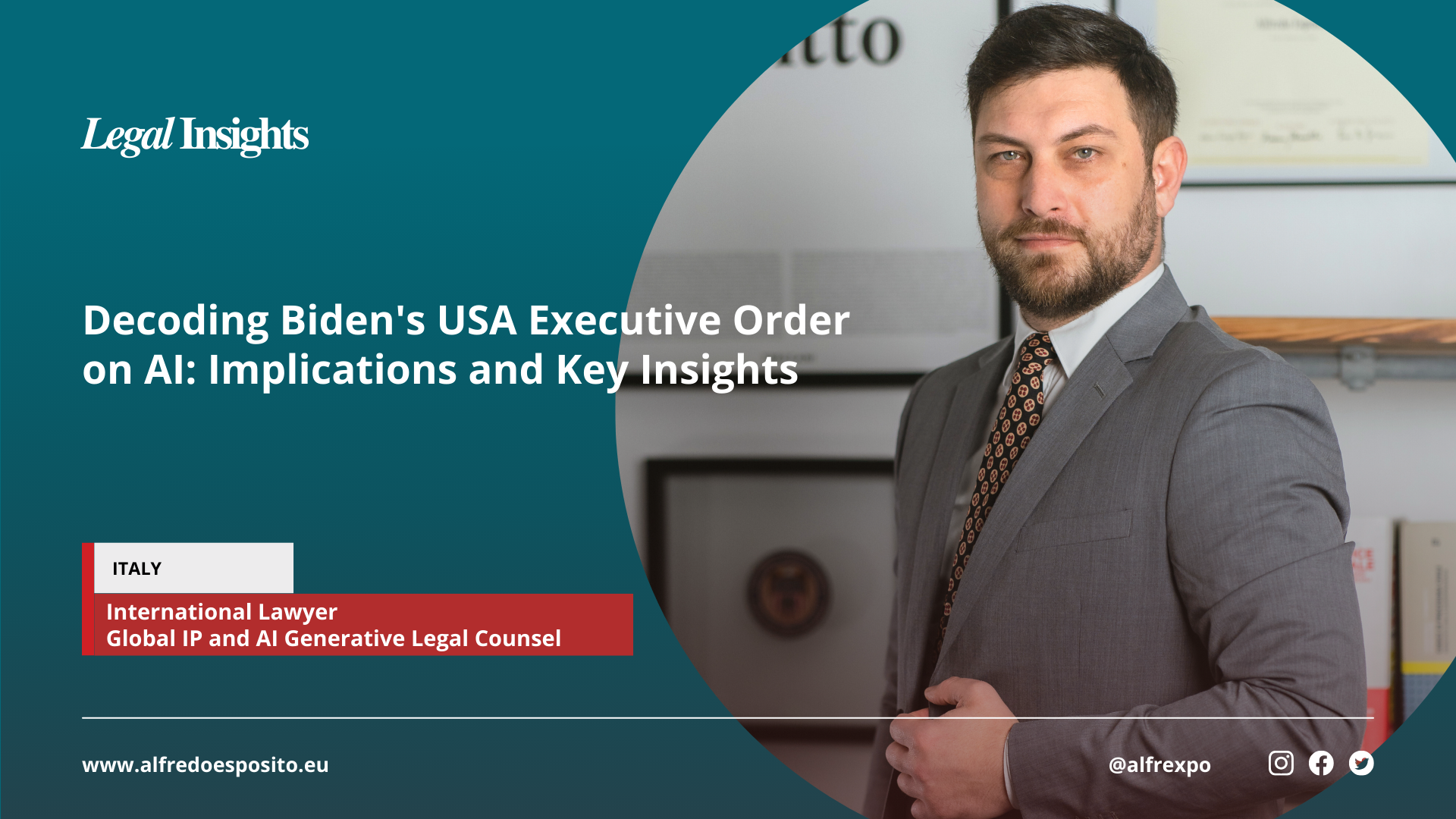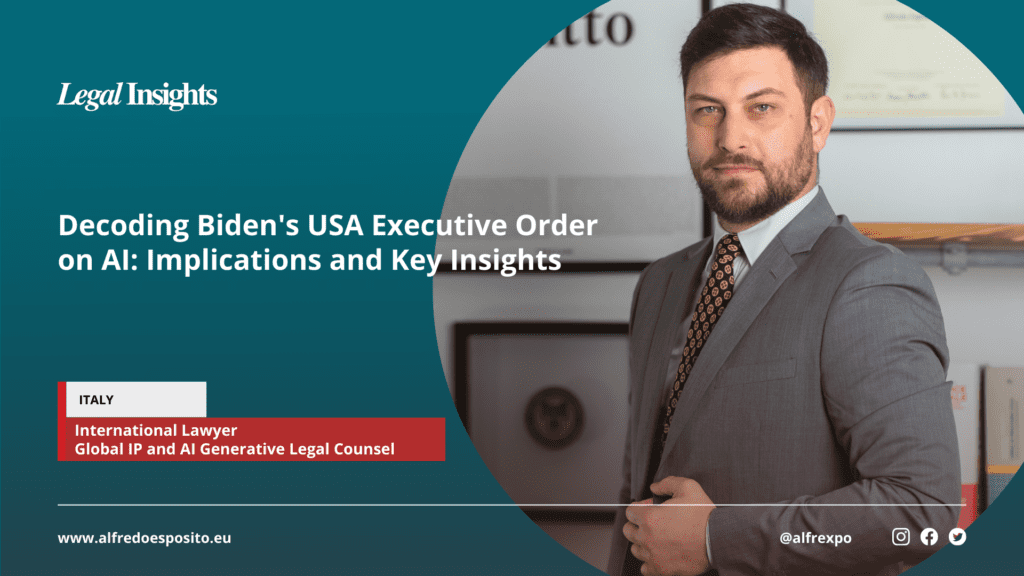
Decoding Biden’s Executive Order on AI: Implications and Key Insights
By aligning the U.S. Executive Order with the European AI Act and the recent Code of Conduct introduced by the G-7, global guidelines and development principles in the field of Artificial Intelligence appear to have been established.
A year after the widespread deployment of Generative AI brought the discussion of Artificial Intelligence to the forefront of public discourse, several significant questions have found answers. Now begins the phase in which these principles and guidelines must be implemented in the real world, recognizing the complexity of achieving a lasting balance given the myriad interests at stake

After months of regulatory fragmentation, with California at the forefront of U.S. Artificial Intelligence legislation, thanks to the Executive Order issued Oct. 30 by President Biden, the United States is finally defining its policy and strategic position on the creation, deployment and use of AI models.
The Executive Order embraces the principle of “responsible innovation” and presents crucial points that will have a decidedly major impact in the immediate future. The United States intends not only to remain at the forefront of AI, but also to ensure that this technology is used responsibly for the benefit of the public and national security.
NEW STANDARDS FOR AI SAFETY AND SECURITY
The first action, to initiate under the Defense Production Act, requires AI system developers to share their test results and other critical information with the U.S. government. This approach, within the context of the U.S. industry landscape, demands significant efforts, considering that state control over industrial assets is strongly disfavored by large companies.
This is especially significant when we consider that the Defense Production Act is an intervention system activated during times of manufacturing crisis (e.g., Clinton in 2006 during the California energy crisis and Biden in 2021 for Covid-19 vaccine production) and it is implemented solely due to emergency contingencies.
When looking for a historical parallel in technology, it was the growing fears of espionage by China that led President Obama in 2011, through the Defense Production Act, to compel telecommunications companies to report on foreign-sourced hardware and software components. The United States’ position becomes clearer when we consider that the recurring keywords in the document emphasize prioritizing AI are “safe, secure, and trustworthy.”
Security will have to be ensured through standards introduced by the National Institute of Standards and Technology, while the Department of Energy and Homeland Security, will have responsibilities regarding potential threats to critical infrastructure.
Expertise also extends to forecasting risks related to biochemical and nuclear as well as cyber infrastructure attacks.
In the debate regarding the spread of fake news and the necessity to prevent scams and manipulation, the U.S. Department of Commerce has been tasked with the important role of developing targeted technical guidance. This guidance aims to ensure the authenticity of AI-generated content.
In particular, to the dismay of content creators and the artistic and publishing world, emphasis is placed on the need to provide a clear indication of the origin of content produced through the use of AI-based models and software.
The decision to create this guide is further underscored by the fact that U.S. government agencies are adopting this tool to assure citizens that communications from the government are authentic and verifiable. This clearly highlights how significant the issue of fake news dissemination and fraud has become, to the point where it necessitates a concrete response from America’s top institutions.
In parallel, the establishment of a specific cybersecurity program aims to further strengthen protection systems. In addition, the creation of a, the development of which will be overseen by the and the White House Chief of Staff, aims to ensure ethical and protected use of Artificial Intelligence by the U.S. military and intelligence forces as well. Simultaneously, the establishment of a dedicated cybersecurity program aims to enhance protection systems. Furthermore, the creation of a National Security Memorandum, overseen by the National Security Council and the White House Chief of Staff, aims to guarantee the ethical and secure utilization of Artificial Intelligence by the U.S. military and intelligence forces.
PROTECTING AMERICAN’S PRIVACY
In the area of privacy protection, the executive order calls for the adoption of a bipartisan law that emphasizes prevention through the development of methodologies that, from the outset, protect personal data without interfering with the AI model training process. As for the commercialization of the data itself, which is considered a resource of growing economic importance, the executive order includes a thorough analysis of how such data is brought to the market. This evaluation process aims, though not without some difficulty, to ensure that the commercialization of data complies with ethical and legal standards while preserving the privacy of citizens.
The privacy-preserving model represents a significant step forward for a country that has been eagerly anticipated by the European Union on such issues. While European policies may sometimes appear characterized by excessive bureaucracy and complexity, it must be acknowledged that the European Union has demonstrated unquestionable leadership in addressing privacy challenges. The global concerns addressed by Biden’s executive order go a long way toward mitigating the criticism previously directed at european national regulators, who were accused of excessive interventionism in the past.
ADVANCING EQUITY AND CIVIL RIGHTS
One of the central issues inherent in AI is the development of cognitive bias that can, regardless of the “unwillingness” of AI, lead to discrimination in critical areas such as justice, healthcare, and housing.
Considering the bias already experienced in the justice system, as exemplified by the COMPAS system we have discussed on these pages, the Biden-Harris administration proposes to take direct action by providing clear anti-discrimination guidelines to federal landlords and contractors in the context of housing rights protection.
In the legal-trial context, the promotion of best practices for the use of intelligence in sentencing, pre-trial proceedings, the pre-trial phase, and detention is encouraged.
The goal is to prevent an individual’s geographic origin or membership in a specific ethnic group from being a source of application inequities.
This clarification may seem obvious but undoubtedly becomes an important foundational principle for the justice system, especially considering that the use of AI is expected to extend beyond the COMPAS system, making adequate protections even more necessary to ensure fairness and the rights of citizens
STANDING UP FOR CONSUMERS, PATIENTS, AND STUDENTS
Planned actions to protect consumers, clinical patients, and students stipulate that the Department of Health and Human Services should receive reports and propose remedies related to the unsafe or harmful use of medical practices involving AI.
In the field of education, the development of learning tools through artificial intelligence models is envisioned. E.g., the development of personalized tutors who can contribute in a tailored manner to the educational needs of students.
SUPPORTING WORKERS
One of the central issues related to the development of Generative Artificial Intelligence is the inevitable loss of jobs related to tasks easily replaceable with AI models. We’ve recently discussed this in relation to dubbing, but the same argument applies to translators, customer service, proofreaders, and in the future, if we consider the predictions of the Do Not Pay company, even for lawyers. Therefore, direct actions are planned to ensure support for all those sectors that will experience a significant reduction in job opportunities.
Even in the job recruitment area, the Executive Order stipulates that professional evaluations should not use models corrupted by bias. Looking at an optimistic view, the integration of AI into the production sector should not result in downward wage competition but rather serve as an engine of economic and social development.
PROMOTING INNOVATION AND COMPETITION
The National AI Research Resource will be the tool in Artificial Intelligence that will enable researchers and students to directly access resources and data, including through direct funding to develop advanced research methodologies in the fields of health and climate change.
Measures are also planned to make technical assistance and resources available to small business and entrepreneurs, pointing to the Federal Trade Commission for support in the commercialization of the latest findings by small companies.
Restrictions on immigration to the United States could be eased through a declared openness to receiving foreign experts for study and work, including through a modernization of visa criteria.
ADVANCING AMERICAN LEADERSHIP ABROAD
The vision of addressing a global challenge is also reflected in cooperation aimed at expanding bilateral and multilateral agreements in the field of AI, including the protection of sensitive infrastructure.
Development along these lines should be coordinated by the State Department in cooperation with the Department of Commerce.
ENSURING RESPONSIBLE AND EFFECTIVE GOVERNMENT USE OF AI
Regarding the administration’s internal training, the President envisions direct training for employees at all levels in relevant fields, including accelerating the hiring of professionals in the field of AI, following the direction of U.S. Digital Service, U.S. Digital Corps and Presidential Innovation Fellowship.
The order closes with a statement and a list of countries with which the government has already cooperated in recent months, also citing the G-7 Hiroshima Process, whose findings and guidelines were released Oct. 30 in conjunction with the executive order. By placing the U.S. Executive Order alongside the European AI Act and the recent Code of Conduct introduced by the G-7, the global guidelines and development principles in the field of Artificial Intelligence seem to have been outlined.
A year after the mass deployment of Generative AI made the discussion of Artificial Intelligence central and public, some important questions have been fully answered.
Now begins the phase in which the principles and guidelines will have to be dropped into the real world, with the knowledge that it will be complex to strike a lasting balance given the scale of the interests at stake.
Avv. Alfredo Esposito


